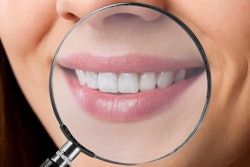
Using calcium-containing bioactive desensitizers during dental whitening procedures doesn't reduce the risk of tooth sensitivity, but they can decrease the intensity, according to a systematic review published on January 28 in Journal of the American Dental Association.
The use of desensitizers did not reduce color change, however, the authors cautioned that the certainty of evidence was low. This is believed to be the first review to evaluate the effect of calcium-containing desensitizers on bleaching-induced tooth sensitivity, the authors wrote.
"We detected a slight decrease in the intensity of TS (tooth sensitivity) when CBs (calcium-containing bioactive desensitizers) were used," wrote the authors, led by Dr. Alessandra Reis, PhD, of State University of Ponta Grossa in Brazil.
A common adverse effect
One of the primary side effects of tooth whitening is bleaching induced-tooth sensitivity, which reportedly affects 50% to 90% of patients. Topical application of a desensitizer is one approach that was used to try to reduce this adverse effect, according to the review.
Tooth sensitivity related to bleaching is not fully understood, but research has suggested that it results from the damage hydrogen peroxide causes in the connective living tissues of the dental structure. Hydrogen peroxide's low molecular weight, strong oxidative potential, and rapid diffusion rate can cause it to cross the dental hard tissues, reaching the pulp chamber and leading to an inflammatory reaction that causes pain.
To explore whether the risk of tooth sensitivity was lower when calcium-containing desensitizers were used with tooth whitening agents in adults compared to when desensitizers weren't used, the authors evaluated 22 studies. Randomized clinical trials that used hydrogen peroxide at varying percentages and compared topical calcium desensitizer application with a placebo or no intervention during bleaching were included in the review, the authors wrote.
In a visual analog scale, tooth sensitivity intensity (mean difference, -0.98; 95% confidence interval [CI], -1.36 to -0.60; p <.0001, very low certainty) was lower in those that used desensitizers. In terms of tooth sensitivity intensity, only eight of the studies had some concerns or a low risk of bias. Most concerns correlated to the bias in measuring the outcome, the authors wrote.
However, there was no difference in the risk of tooth sensitivity (risk ratio, 0.95; CI, 0.90 to 1.01; p = .08, low certainty), and the color change was unaffected (p > .08), according to the review.
Although the mean difference in the intensity of tooth sensitivity was statistically significant, from a clinical standpoint, its relevance is questionable. For instance, a shift in intensity from three visual analog scale (VAS ) units to two VAS units may not be very valuable clinically, considering that whitening-induced tooth sensitivity only lasts a maximum of 48 hours. Considering the results, "most patients will experience some discomfort during the treatment but with a subtly lower TS intensity," the authors wrote.
A need for better studies
Since the review showed that the certainty of the studies was low and very low for the outcomes evaluated, more needs to be done to improve the quality of the random clinical trials for tooth whitening studies. In the future, trials should investigate other types of desensitizing agents to prevent or reduce the adverse effects of whitening-induced tooth sensitivity, the authors wrote.
"This finding, although positive in favor of the CBs, should be interpreted with caution owing to the low certainty of the body of evidence collected," Reis and colleagues concluded.




















